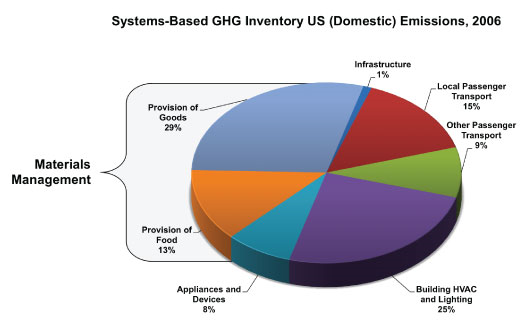Resources, Waste and Greenhouse Gas Emissions
Decisions about how goods (such as food, plastic packaging, and building materials) are produced, transported, used, and disposed of can make a big difference in the amount of the resources used, greenhouse gases emitted, environmental impacts created, and waste produced. Greenhouse gas (GHG) emissions and other environmental impacts associated with goods result from the energy, land, and water used to produce, transport, consume, and dispose of them. According to the Global Resources Outlook 2019 report from the United Nations Environment Programme’s International Resource Panel, up to half the global GHG emissions stem from the extraction and processing of materials, fuels, and food. Reducing, reusing, recycling, and composting are strategies that can lessen the environmental impact of goods.
EPA is working to develop more information on the environmental, social, and economic impacts of goods and services. We are improving our life cycle information and data on the potential impacts of the materials required to produce those goods and services. This information, once available, can help interested parties across the U.S. address the environmental, social, and economic impacts occurring domestically and internationally from the production and consumption of goods in the United States.
In 2009, EPA reallocated the GHG Emissions Inventory using a systems-based approach. EPA found that more than 40 percent of U.S. GHG emissions result from production, transportation, use, and disposal of material goods. A Sustainable Materials Management approach focuses on using and reusing resources efficiently and sustainably from extraction to end of life. It aims to generally minimize material use and all associated environmental impacts.

Learn How Reducing
Waste Decreases Our
Carbon Footprint

What Businesses and
Communities Can Do

Resources
- Facts and Figures About Materials, Waste and Recycling.
- Sustainable Materials Management Web Academy – Webinar Recordings and Slides.
- Managing and Transforming Waste Streams: A Tool for Communities.
- Food Waste Research.
- Examples of Local Government Action Plans that Address Materials Management and Waste.
- Food Waste and Methane Fact Sheet (pdf)(2.1 MB). Access this Fact Sheet in Spanish.
- Wasted Food Infographics.



